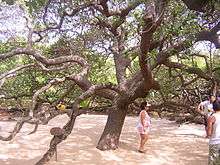Maior cajueiro do mundo





Maior cajueiro do mundo or Cajueiro de Pirangi (English: world's largest cashew tree or cashew tree of Pirangi) is a cashew tree in Pirangi do Norte, Rio Grande do Norte, Brazil.[1] In 1994, the tree entered the Guinness Book of Records.[1] It covers an area between 7,300 square metres (1.8 acres)[2] and 8,400 square metres (2.1 acres).[3] Having the size of 70 normally sized cashew trees,[3][4] it has a circumference of 500 m (1,600 ft).[4] The vicinity of the World's Largest Cashew Tree in North Pirangi is also main place for the sale of lace and embroidery in Rio Grande do Norte state.[5]
The spread over a hectare of land was, unlike other trees, created by the tree's outwards growth which, when bent towards the ground (because of their weight), their branches tends to take new roots where they touch the ground.[6][7] This may be seen in the images of the interior. It is now difficult to distinguish the initial trunk from the rest of the tree.[8]
The tree is said to have been planted in 1888.[1] However, based on its growth nature, "the tree is estimated to be more than a thousand years old.".[6] The tree produces over 60,000 fruits each year.[9][10]
References
- 1 2 3 "Natal Tourist Attractions: Sightseeing and Attractions in Natal Area, Brazil", World-Guides.
- ↑ Box, Ben (2003). South American handbook, Volume 80, p.512. ISBN 978-1-903471-70-8.
- 1 2 M. Angela A. Meireles (2008). Extracting Bioactive Compounds for Food Products: Theory and Applications, p.332. ISBN 978-1-4200-6237-3.
- 1 2 Margaret Kelly, ed. (2008). Fodor's Brazil, p.453. ISBN 978-1-4000-1966-3.
- ↑ Various authors. Artes e rituais do fazer, do servir e do comer: No Rio Grande do Norte (Art and Ritual of Making and Serving Food: In Rio Grande do Norte), p.44. ISBN 978-85-7458-251-1. (Portuguese)
- 1 2 Clay, Jason W. (2004). World agriculture and the environment: a commodity-by-commodity guide to impacts and practices, p.264. ISBN 978-1-55963-370-3. Cites Morton, Julia. (1987). "Cashew Apple", Farofa of Warm Climates, p.239-249. Miami, FL. Creative Resource Systems, Inc.
- ↑ "Maior cajueiro do mundo", BrazilTravelBuddy.com.
- ↑ Felippe, Gil (2004). Frutas: sabor à primeira dentada (Fruit: Taste the First Bite), p.48. ISBN 978-85-7359-421-8. (Portuguese)
- ↑ Let's Go, Inc. (2003). Let's Go Brazil, p.6. ISBN 978-0-312-32004-1.
- ↑ Waggoner, John. Northeastern Brazil : The Dende Coast, Chapada Diamantina, the Marau Peninsula, the Cocoa Coast, Penambuco & Beyond. ISBN 978-1-58843-956-7. Same text & author: ISBN 978-1-58843-676-4.
External links
 Media related to Maior cajueiro do mundo at Wikimedia Commons
Media related to Maior cajueiro do mundo at Wikimedia Commons
Coordinates: 5°58′43″S 35°07′24″W / 5.978657°S 35.123372°W